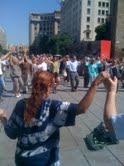 Dancing for Independence: The weekly Sardana in Barcelona's Old Town
Dancing for Independence: The weekly Sardana in Barcelona's Old Town
But the new constitution was shot down by Spain’s Constitutional Court three months ago, which declared that the central government alone can legally rule, with no self-rule allowed. A huge demonstration, the biggest in 20 years, followed in Barcelona on July 6th. “Tension is growing daily,” says Guillem, the 22-year-old concierge at our hotel, who resembles a young Paul Newman.
Europe is becoming simultaneously more centralized and more fragmented in a process of devolution, with separatist movements extending from the UK to Belgium to Spain and over into Eastern Europe. “Under the EU, nations are weaker,” contends Diego, Guillem’s 32-year-old dark-eyed sidekick, originally from Brazil. “It’s a continuum that started with the colonies in the 20th century. Spain is tearing apart.”
September 11th takes on a far different meaning here in Catalonia. On that day — known here as La Diega — in 1714, Catalonia lost its independence following the War over the Succession of Spain. “It reminds us that we are oppressed,” explains Ferran. In 1980, the first act of the newly established Catalan legislature was to declare La Diega a national holiday.
Though it had a rich literary heritage, and at the height of Catalan political power in the 13th and 14th centuries was spoken as a commercial language as far away as Naples and Athens, the Catalan language was banned or repressed during most of the 18th and 19th centuries, though it was still spoken by Catalonians at home.
Catalonia’s oppression was exacerbated by the dictator, General Francisco Franco, who banned books in Catalan and also the public use of the language, forcing everyone to speak Spanish. “Now we speak Catalan,” states Guillem proudly. “People say, ‘What is that? You’re not speaking Spanish.’ We want them to understand that we are not Spanish.”
A key reason for Franco’s repression was that Catalonia and its capital, Barcelona, were at the very heart of the battle for the Second Spanish Republic, a democratically elected government that had boldly challenged Spain’s conservative landed establishment, denying Church rights and promoting human ones, like divorce and women’s suffrage. The short-lived Republic also allowed the communitats the option of independence, an option which Catalonia took in 1932.
The utopian allure of the Spanish Republic is beautifully captured in Homage to Catalonia, published in 1938 by George Orwell, who joined the International Brigade and fought with the militia against Franco. Arriving in December, 1936, he wrote, “It was the first time that I had ever been in a town where the working class was in the saddle.” Orwell “recognized it immediately as a state of affairs worth fighting for.” And where else but Barcelona can you find a Calle de George Orwell, its residents proudly displaying the red-and yellow striped flag, the senyera, of Catalan from their apartment windows?
Backed by the Soviets and Mexico, the Republic was opposed not just by Italy and Germany, but also the U.S., France and England. Indeed, Britain and the U.S. went so far as to establish blockades to prevent arms from reaching the Republicans. They aimed to simultaneously block the Soviets and appease the fascists by letting Franco’s fascists win, a misbegotten tactic of appeasement later repeated when Hitler marched into the Sedatenland in Czechoslovakia. Brutally abetted by Hitler and Mussolini, with the blessing of the ruling Spanish Catholic bishops, Franco crushed the Republic in 1939 and went on to rule Spain for 35 years until his death in 1976. “I remember being in Barcelona right after Franco died,” my editor writes. “It was electric. Catalan flags everywhere.”
After Catalonia fell in 1939, Republicans who tried to escape to France by land or sea were blocked and returned only to be slaughtered by Franco’s military. Reportedly, over 100,000 people disappeared into mass graves – a topic that remains taboo in Spain even today. Academics engage in “archive wars” to unearth the Civil War documentation held by the Church and the conservative government of Salamanca, one of Franco’s wartime capitals. Outside of Guernica the Basque city that was the first to be subjected to aerial bombardment (by German warplanes) in an event immortalized by Pablo Picasso’s famous mural, there is scant museum coverage of the era. Moreover, in October, 2008, when the renowned Judge Baltasar Garzon of Spain’s National Court launched an unprecedented inquiry into the “crimes against humanity” of the Franco era, BBC News reported that “under heavy pressure from the right-wing civil servants union, he withdrew the investigation”.
Today, it is not the children, but the grandchildren of the Republic who tell me of their intense desire for “respect” and their hopes that they may soon reclaim the heritage that has hitherto eluded them.
* * *
If history teaches us anything, it’s that it doesn’t go away. Try as some politicians may, governments cannot erase or evade the past. On September 12th, my husband and I went to see the traditional Catalan dance, the Sardana, which had been banned under Franco. A symbol of Catalan unity, a public dance takes place every Sunday at noon outside of the main Cathedral, Basilica La Seu. Accompanied by a small band, called a cobla, the Sardana is a deceptively simple, rustic dance, practiced by old and young, comfortable and poor, attired in casual street clothes, holding hands, arms raised in a slowly moving circle — a continuum, like time, folding onto itself unbroken.
